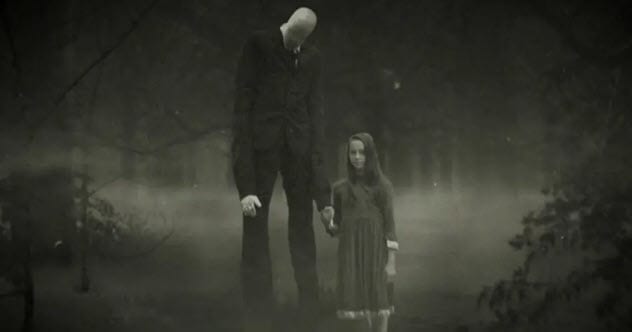The internet is a vast playground for creativity, birthing trends, memes, and sometimes, something far more sinister. We all vaguely know the Slender Man – that unnervingly tall, faceless figure lurking in the digital shadows. Born from a 2009 internet forum contest, this phantom quickly transcended its fictional origins. But what happens when an urban legend becomes too believable? The Slender Man’s tale is a stark reminder that the lines between online myth and offline consequence can blur, leading to events that are chillingly real. Get ready to explore ten unsettling truths where the legend of the Slender Man crept out of the screen and into our world.
10. Very Definite Origins
Unlike many other myths, the Slender Man’s beginnings are crystal clear. On June 10, 2009, a user named Victor Surge (real name Eric Knudsen) posted two manipulated photographs on the Something Awful internet forum. He did this for a challenge to create “paranormal images” that might fool people into thinking they were real.
The first picture, supposedly from 1983, depicted distressed children with a remarkably tall, faceless man in the background. The caption read: “We didn’t want to go, we didn’t want to kill them, but its persistent silence and outstretched arms horrified us and comforted us at the same time!” This was attributed to an unknown, “presumed dead” photographer.
The second image was dated 1986. It showed happier children playing in a park, with the same tall figure subtly present. The caption stated it was “one of two recovered photographs from the Stirling City Library blaze” and noted it was taken “the day which fourteen children vanished,” specifically mentioning “Slender Man.” The photographer, Mary Thomas, was listed as missing since June 1986. These images didn’t just start the Slender Man legends; they captivated thousands almost instantly.
9. A Legend Made by “The People”
While Knudsen created Slender Man, it was the Creepypasta community that truly fleshed him out. As more people learned about Slender Man, they added their own details and backstory, causing the legend to expand. He was often shown with a white, featureless face, very slim, unusually tall, and sometimes with tentacles emerging from his back.
He also became linked with abandoned buildings, frequently in wild or wooded areas. Later additions even claimed Slender Man could teleport. Fans “agreed” on signs of his presence, such as sudden paranoia, nosebleeds, and intense nightmares. This communal creation of a modern myth highlights how digital folklore evolves.
8. See a Legend Grow and Develop
Experts in folklore and mythology have studied the Slender Man legend to see how such stories grow and spread. By observing its development, they hope to understand how ancient legends might have formed similarly. There’s a strong collective aspect to Slender Man’s growth, as noted earlier. Details often change depending on who’s telling the story or the audience.
The more Slender Man accounts were shared (online, rather than by word of mouth), the more the legend and its backstory expanded. Very quickly, the Slender Man legend took on a life of its own, much like historical myths. However, a few years after his creation, Slender Man became “real” in a much more disturbing way.
7. The Slender Man Stabbing
On May 31, 2014, the Slender Man legend spilled into the real world with shocking consequences. Two 12-year-old girls, Anissa Weier and Morgan Geyser, attempted to murder their friend, Payton Leutner, by stabbing her multiple times in the woods. Payton, left for dead, managed to crawl to safety and was found by a cyclist.
The girls were arrested shortly after. During questioning, Weier stated they attacked their friend to please the Slender Man. They also believed they knew where he lived—an old house in the Nicolet National Forest—and were heading there when caught. For everyone involved, the consequences of the Slender Man legend became terrifyingly real. Weier was released from a mental health facility in 2021, while Geyser remains incarcerated. Payton Leutner survived her nineteen stab wounds.
6. The Copycat Cases
After the horrifying attack on Payton Leutner, several similar incidents occurred, all linked in some way to the Slender Man legend. Just weeks later, in June 2014, a 13-year-old girl in Hamilton County, Ohio, attacked her mother with a knife. Investigators found she had an “obsession” with Slender Man.
A few months later, in September 2014, a 14-year-old girl in Port Richey, Florida, set her family’s house on fire. Reports indicated she was ‘inspired’ by Slender Man. Fortunately, everyone inside escaped, and the girl was arrested the next day. Even a tragic case in Las Vegas in summer 2014, involving the murder of two police officers and a civilian, followed by the perpetrators’ suicides, was connected. Neighbors reported that the male killer often dressed as Slender Man.
5. Suicides Connected to the Slender Man
In the summer of 2015, The New York Times reported on a string of suicides among young people, aged 12 to 24, on the Pine Ridge Reservation in South Dakota over the previous six months. What’s particularly concerning is that the article mentioned that “several officials with knowledge of the cases said that at least one of the youths who committed suicide was influenced by Slender Man.”
Adding another layer to these tragic deaths are the reservation’s own legends. They speak of a spirit named the Tall Man or Walking Sam, who supposedly encouraged chosen individuals to take their own lives. While the similarity between the Slender Man and these Native American legends might be coincidental, their convergence within this community could have had devastating outcomes.
4. Aborted Mass Suicide and Connections to Native American Legends
A truly grim story emerged from the same reservation about a narrowly prevented mass suicide. According to the account, several teenagers abruptly went to a specific spot in the woods and began tying ropes to tree branches, clearly intending to hang themselves as a group.
John Two Bulls, the local pastor on the reservation, heard about these horrifying plans and rushed to the location. Thankfully, he managed to stop the teens and seemingly break them out of whatever group trance they appeared to be in. Whispers from the reservation suggested that the attempted mass suicide was due to a visitation by Walking Sam. Given the widespread attention Slender Man was receiving at the time, it’s understandable how some in the media linked the legend of the suicide spirit with this modern urban legend.
3. “Lacy” – A Truly Bizarre Account
Paranormal researcher Nick Redfern shared a particularly strange story told to him by a witness he called “Lacy.” She claimed to have had several real-life, though not physical, encounters with the Slender Man. Lacy said she had been researching Slender Man for months when, one evening, her laptop, which was in sleep mode, suddenly turned on by itself. A faceless creature appeared on the screen but vanished quickly.
She tried to dismiss it as her imagination. However, two nights later, the laptop turned on again. This time, the face was much clearer. After several weeks of quiet, her laptop came on once more. A strange voice from the device said, “we are friends.” At that point, Lacy shut down her laptop and stopped her research into the Slender Man. While it’s possible Lacy experienced hallucinations due to her intense focus and fear, it highlights how thin the line can be between belief and a legend feeling intensely real.
2. Intense Internet Debate
As one might expect, a heated debate erupted after the stabbing and the copycat cases that followed. Initially focused on Slender Man, the discussion soon shifted to the internet’s general influence on children. For instance, in the Waukesha School District, where Payton Leutner was attacked, the Creepypasta Wiki website was blocked. The site’s administrators argued that the stabbing was an “isolated incident,” emphasizing that their website focused on literature and did not endorse violence.
Ultimately, many reasoned that access to various movies, TV shows, and video games didn’t typically lead to such horrific attacks. The consensus leaned towards the problem lying with the individuals involved rather than solely with the apparent catalyst. Though the debate started with significant momentum, its influence gradually waned.
1. A Contemporary Equivalent of the Boogeyman
There’s little doubt that Slender Man is the Boogeyman of our modern era. If you speak to almost anyone under 20 in the Western world, they’re likely to know who Slender Man is. They might not know his history or even how they first heard of him, but he’s part of their collective subconscious. Even if they understand he’s just an urban legend, his presence is felt.
Clear similarities exist between Slender Man and the traditional Boogeyman. Both are said to stalk children, and both inhabit grim, secluded locations, often in woods. What the future holds for the Slender Man legend is yet to be seen. Perhaps, centuries from now, spooked youngsters around the world will still whisper his name, just as they do today.
The journey of the Slender Man from a simple forum post to a global phenomenon is a fascinating, if unsettling, modern fable. It highlights how collective imagination can breathe life into a character, blurring the lines between story and perceived reality. While the Slender Man remains a creature of fiction, its impact on the real world—inspiring art, fear, and tragically, violence—is undeniable. This internet legend serves as a potent example of how digital folklore can shape and sometimes distort our understanding of the world around us.
What are your thoughts on the Slender Man phenomenon? Have you ever felt the chill of this modern legend? Leave your comment below and share your experiences!










